Blogs

Understanding Ti 21S: A Complete Tutorial on Properties and Applications in Manufacturing
Introduction
In the realm of advanced materials, Ti 21S has emerged as a formidable player, redefining standards across various industries. This innovative titanium alloy is celebrated for its remarkable strength-to-weight ratio, exceptional corrosion resistance, and versatility in manufacturing processes. As procurement managers navigate the complexities of sourcing materials, understanding the unique attributes and applications of Ti 21S becomes crucial.
From aerospace to biomedical devices, this alloy is not just a material choice but a strategic asset that enhances performance and operational efficiency. As the demand for lightweight, high-performance components continues to surge, exploring the potential of Ti 21S offers valuable insights into optimizing procurement strategies and driving innovation in modern manufacturing.
Fundamental Properties of Ti 21S: An Overview
The cutting-edge titanium composition known as ti 21S is distinguished by its exceptional blend of strength, corrosion resistance, and lightweight attributes. Its key characteristics include:
High Strength-to-Weight Ratio: Ti 21S showcases impressive tensile strength while maintaining a low density, making it particularly advantageous for applications where weight reduction is critical. Notably, substituting steel components with Titanium Beta 21 can facilitate a weight reduction of up to 40%, enhancing overall performance in aerospace and automotive designs.
As noted by the Aeronautical Development Agency (ADA), ‘Substituting steel components with a specific material can lead to a possible weight reduction of 40%.’Corrosion Resistance: This material is exceptionally resistant to oxidation and corrosion, a vital feature for durability in challenging environments such as marine and chemical processing sectors. The ADA highlights that the corrosion resistance of ti 21S significantly extends the lifecycle of components in these demanding applications.
Workability: Ti 21S demonstrates excellent workability as it is amenable to various manufacturing processes, including forging, rolling, and additive manufacturing, which simplifies its integration into existing production workflows and supports diverse applications.
Biocompatibility: The non-toxic characteristics of Ti 21S make it suitable for biomedical uses, such as implants and prosthetics, where compatibility with human tissue is essential.
Recent innovations in titanium materials, including the launch of new stealth aircraft and high-strength metastable beta titanium materials, underscore the ongoing advancements in the field, making the procurement of ti 21S a timely choice for managers. Furthermore, the case study named ‘Advantages and Challenges of Using Titanium Beta 21‘ emphasizes the equilibrium between performance advantages and related challenges, essential for maximizing the application of this alloy in particular projects.
These characteristics establish ti 21S as a leading choice across various sectors, particularly in aerospace, automotive, and biomedical fields, where advanced substances can drive innovation and improve operational efficiency.
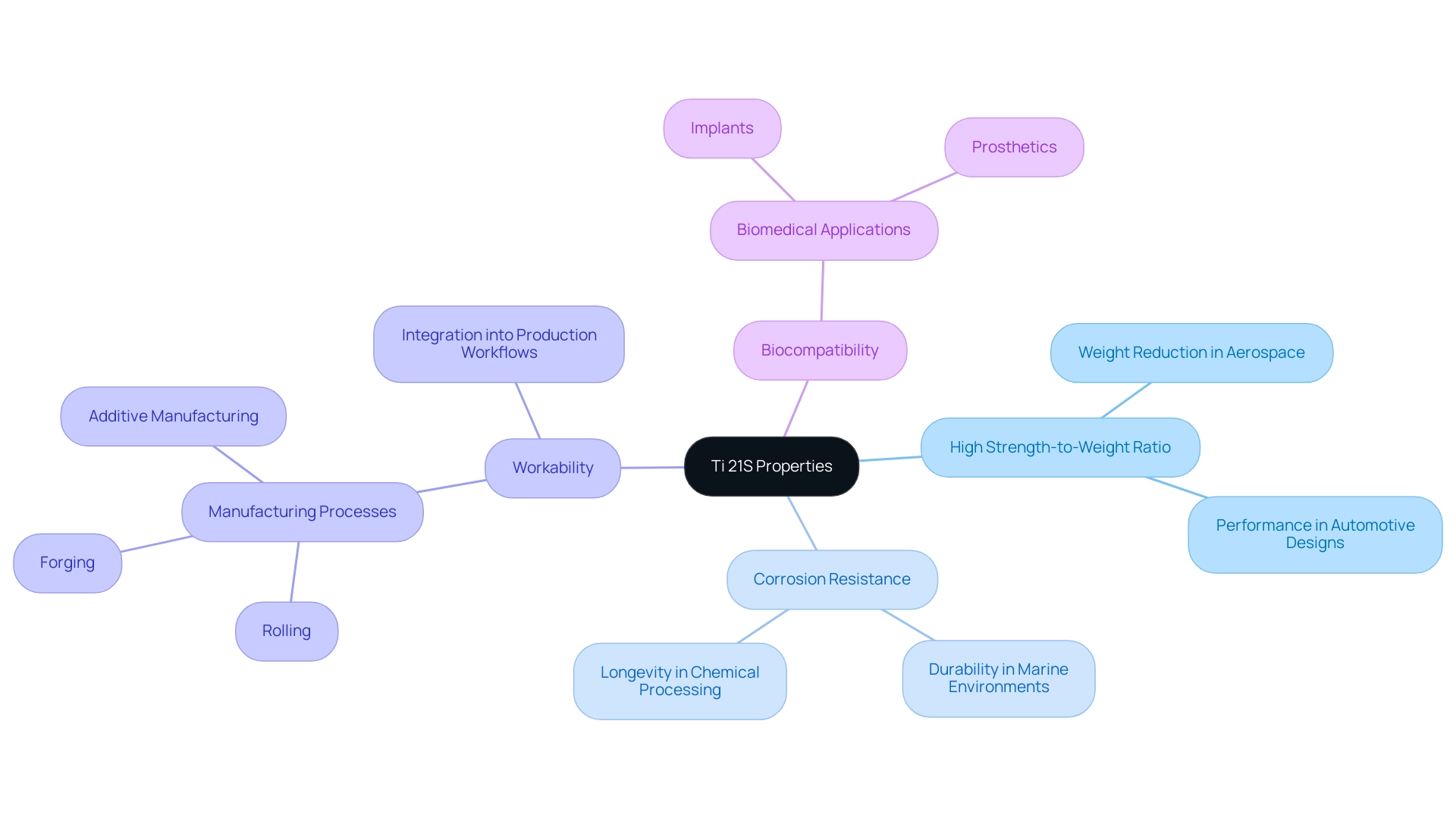
Applications of Ti 21S in Modern Manufacturing
Ti 21s is increasingly recognized for its exceptional properties, making it a pivotal material across a range of sectors. Key applications include:
- Aerospace Components: The aerospace industry extensively utilizes Ti 21S for critical parts such as turbine engines, airframes, and fasteners. Its combination of performance and weight-saving characteristics is essential for enhancing aircraft efficiency and operational effectiveness.
- Automotive Parts: In the automotive sector, the material ti 21s plays a crucial role in high-performance components, including exhaust valves and suspension systems. Its use in these contexts contributes significantly to overall vehicle efficiency, performance, and sustainability.
- Biomedical Devices: The biocompatibility of ti 21s makes it a preferred choice for surgical implants and prosthetics, as its strength and corrosion resistance enhance patient outcomes and dependability in medical applications.
- Marine Equipment: The intrinsic corrosion-resistant characteristics of ti 21s render it an ideal option for marine applications, including components for ships and offshore structures that are frequently subjected to harsh saltwater environments.
- Chemical Processing: Ti 21S is frequently employed in chemical processing equipment due to its robustness against corrosive substances, ensuring that Ti 21S provides longevity and reliability in demanding production environments.
These programs not only emphasize the strategic significance of ti 21s in current manufacturing but also highlight its role as an essential component within modern engineering practices. Furthermore, procurement managers can connect with 5-20 qualified titanium companies in their region to explore sourcing options. As Jax Precision notes, “Our team has experience in rapid prototyping to get your project off the ground fast,” emphasizing the material’s role in expediting project initiation.
Moreover, the company’s dedication to competitive pricing through Lean principles highlights the economic benefits of employing ti 21s in various applications.
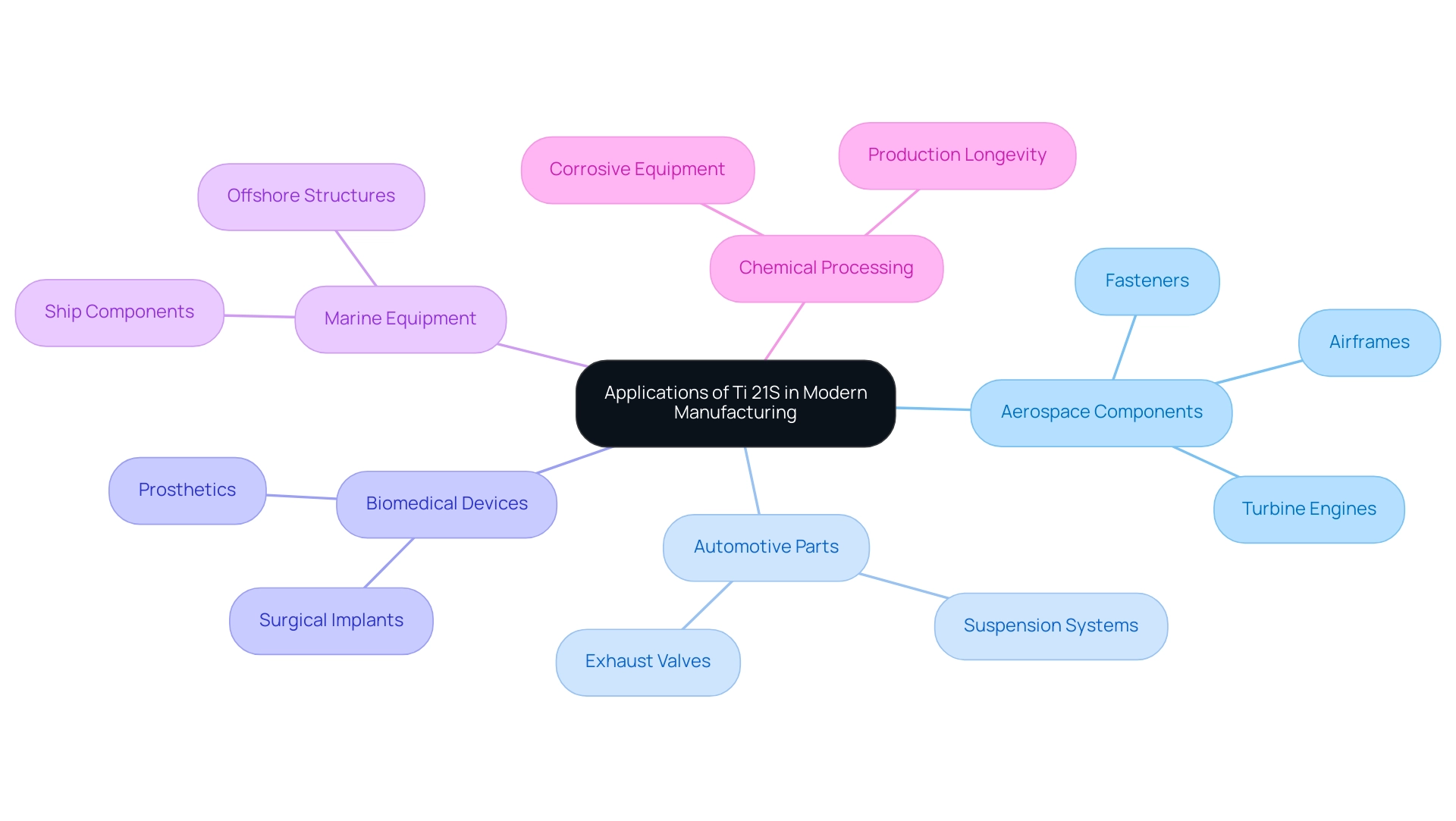
Comparative Analysis of Ti 21S with Other Titanium Alloys
The comparison of Ti 21S with other titanium materials, particularly Ti 6Al-4V and Ti 3Al-2.5V, reveals significant insights for procurement managers:
Ti 6Al-4V: Renowned for its exceptional strength and corrosion resistance, Ti 6Al-4V is extensively utilized in the aerospace and medical sectors. In fact, the Airbus A350 consists of 14% titanium by weight, highlighting the significance of weight considerations in aerospace uses. However, Ti 6Al-4V is heavier than Ti 21S, which makes Ti 21S a more advantageous option when weight reduction is a priority. Furthermore, specifications for Ti 6Al-4V, including UNS: R56400, AMS Standard: 4928, ASTM Standard: F1472, and ASTM Standard: B265, underscore its compliance with industry standards, ensuring quality and performance in uses.
Ti 3Al-2.5V: This alloy is recognized for its good weldability and is frequently employed in aerospace sectors. While it offers ease of fabrication, it does not achieve the same level of corrosion resistance as Ti 21S, which is essential in demanding environments. The comparative durability of Ti 21S can lead to enhanced longevity in uses where environmental exposure is a concern.
Cost Considerations: The Ti 21S typically presents a cost-effective solution, particularly in high-volume production scenarios. Its favorable cost-to-performance ratio makes it an attractive option for manufacturers eager to optimize production without compromising on quality.
As A. S. Kuryndina noted regarding the importance of material selection, it is essential for procurement managers to consider the implications of their choices on overall performance and longevity. Through these comparisons, procurement managers can make strategic selections of titanium materials, aligning their choices with performance requirements, cost constraints, and the specific needs of their applications.
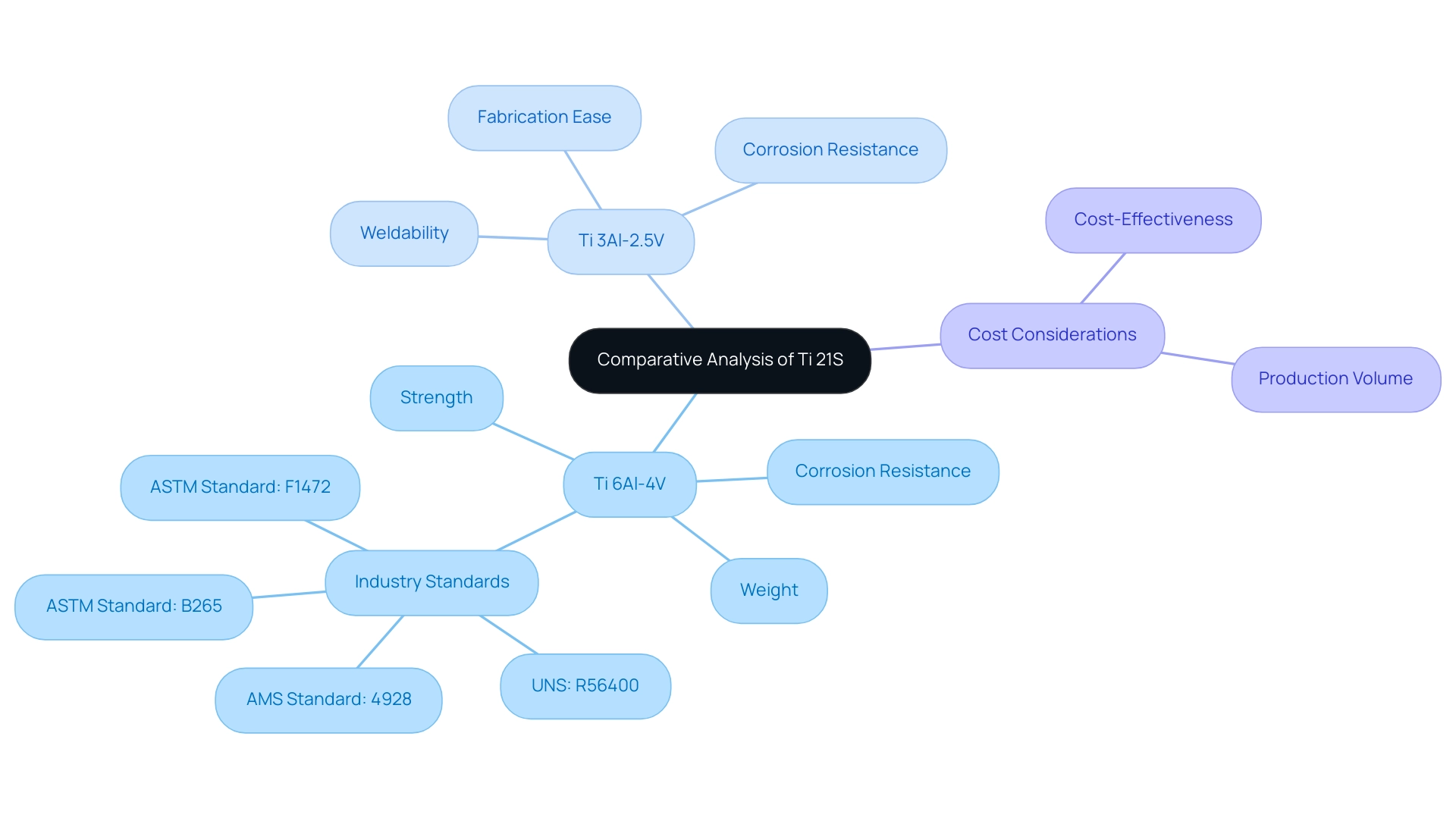
Best Practices for Sourcing Ti 21S
To effectively source Ti 21S, procurement managers should adopt the following best practices:
Evaluate Supplier Credentials: It is crucial to select suppliers who specialize in titanium alloys and demonstrate a robust track record in quality assurance and compliance with international standards, such as ASTM and ISO. This not only minimizes risks but also guarantees a reliable supply chain. Additionally, consider suppliers of non-sparking tools, such as those made from titanium or specialized materials, that are essential in explosive environments, ensuring they maintain high safety standards. As highlighted by Vibrant, “We have used Process Compensated Resonant Testing (PCRT) for studying structural integrity and functional performance of ceramic balls used in various auxiliary power units (APUs), propulsion engines, and defense and space missiles,” indicating the importance of rigorous testing in supplier selection.
Conduct Substance Testing: Implementing rigorous substance testing protocols is essential to verify that the metal meets all required specifications prior to procurement. This process should encompass a variety of tests, including tensile strength assessments, corrosion resistance evaluations, and comprehensive microstructural analysis. Significantly, a 2017 study demonstrated the effectiveness of using PCRT sorting modules for the detection and quantification of creep strain in substances, underscoring its relevance in ensuring the integrity and performance of titanium alloys. Furthermore, consider the electrical insulation properties of related products, such as mica tape, which is known for its high-temperature resistance and dielectric strength, making it crucial in high-temperature applications like electrical insulation in motors and transformers.
Negotiate Terms: Utilize negotiation skills to secure advantageous pricing and terms while clearly communicating quality expectations and delivery schedules to suppliers. Effective negotiation can lead to mutually beneficial agreements that align with organizational objectives.
Build Long-Term Relationships: Cultivating strong relationships with suppliers enhances collaboration and support. Long-term partnerships can lead to enhanced pricing, priority service, and access to cutting-edge innovations, ultimately benefiting your procurement strategy. This is especially crucial when sourcing electrical insulation resources, such as mica tape and non-sparking tools, as ongoing relationships can facilitate better insights into new product developments and innovations.
By adhering to these practices, procurement managers can significantly enhance their sourcing strategy for Ti 21S, ensuring that procurement activities align with both organizational goals and evolving industry demands.
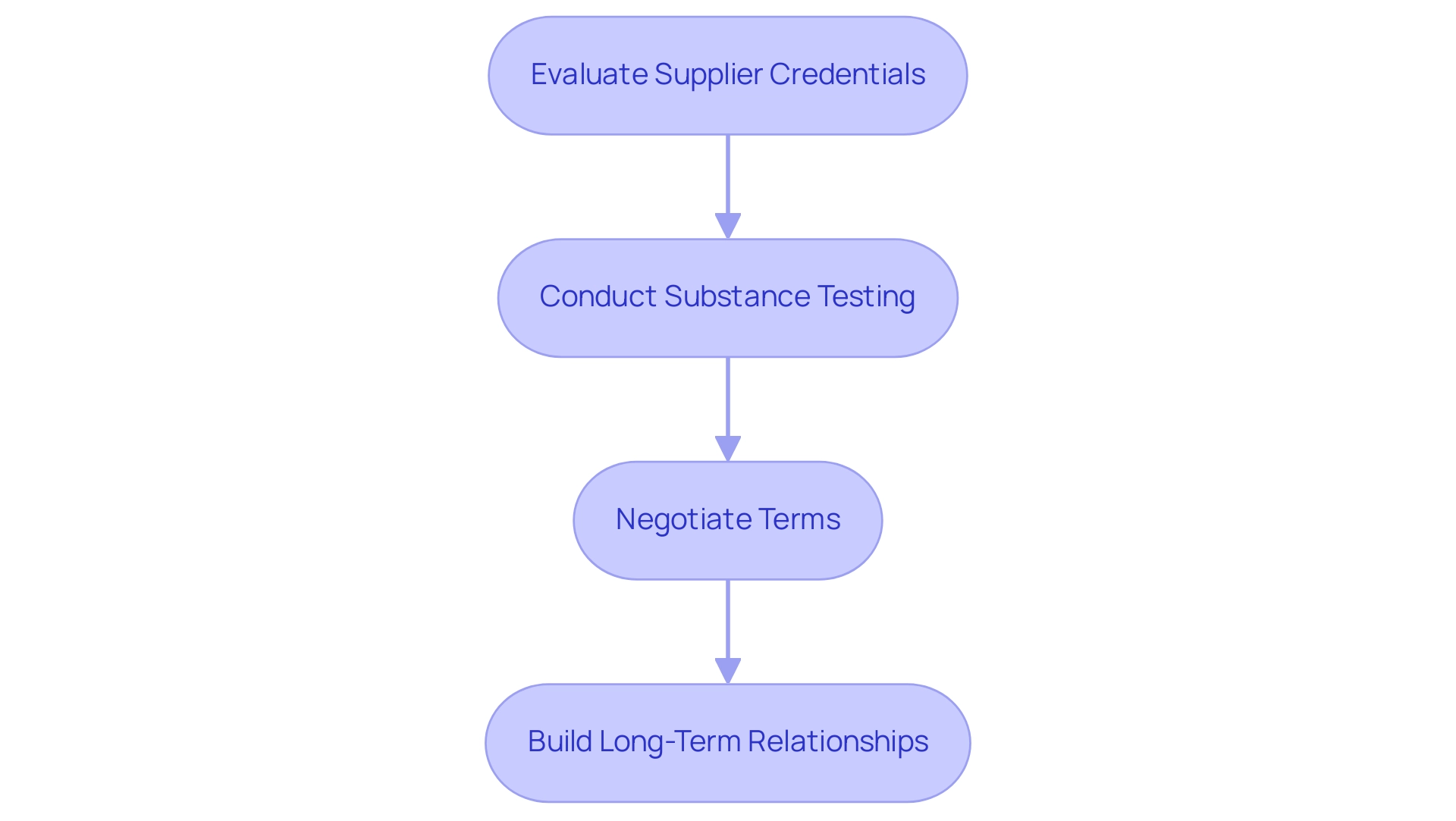
Future Trends in Ti 21S Applications
The outlook for Ti 21S in manufacturing is exceptionally promising, driven by several emerging trends:
Increased Demand in Aerospace: As aerospace technology continues to evolve, the requirement for lightweight, high-performance materials like Ti 21S is projected to rise significantly. This is particularly relevant in the context of developing next-generation aircraft and space exploration vehicles, where weight reduction is critical for performance and efficiency. The need for innovative materials is underscored by the increasing citation of related research, such as the article on Ta(Zn)O thin films, which has been cited 12 times and viewed by 3,778 individuals. The ongoing advancements in healthcare technology are likely to propel the use of Ti 21S in medical devices and implants, emphasizing its role in biomedical applications. Its remarkable biocompatibility and mechanical strength render it an ideal choice for use in patient care. As mentioned by Wonki Jeong, “Microstructure and mechanical properties of Ti-6Al-4V/equine bone composites fabricated by ball milling and spark plasma sintering (SPS) have been investigated,” emphasizing the potential for Ti 21S in comparable uses.
Sustainability Initiatives: With an increasing focus on sustainable manufacturing practices, Ti 21S is distinguished by its recyclability and durability. Manufacturers are drawn to this alloy as they seek to minimize their environmental footprint while maintaining high-performance standards, aligning with broader industry sustainability goals.
Innovation in Additive Manufacturing: The rise of 3D printing technologies is unlocking new possibilities for Ti 21S, allowing for the creation of complex designs and customized components. This innovation is particularly advantageous in high-value sectors such as aerospace and automotive, where precision and adaptability are paramount. The case study on titanium–equine bone biocomposites demonstrates the enhanced mechanical properties and uniform dispersion of materials, indicating the potential benefits of Ti 21S in biomedical applications.
By keeping abreast of these trends, procurement managers can strategically adjust their approaches to effectively leverage Ti 21S, ensuring they remain competitive in a rapidly evolving market landscape.
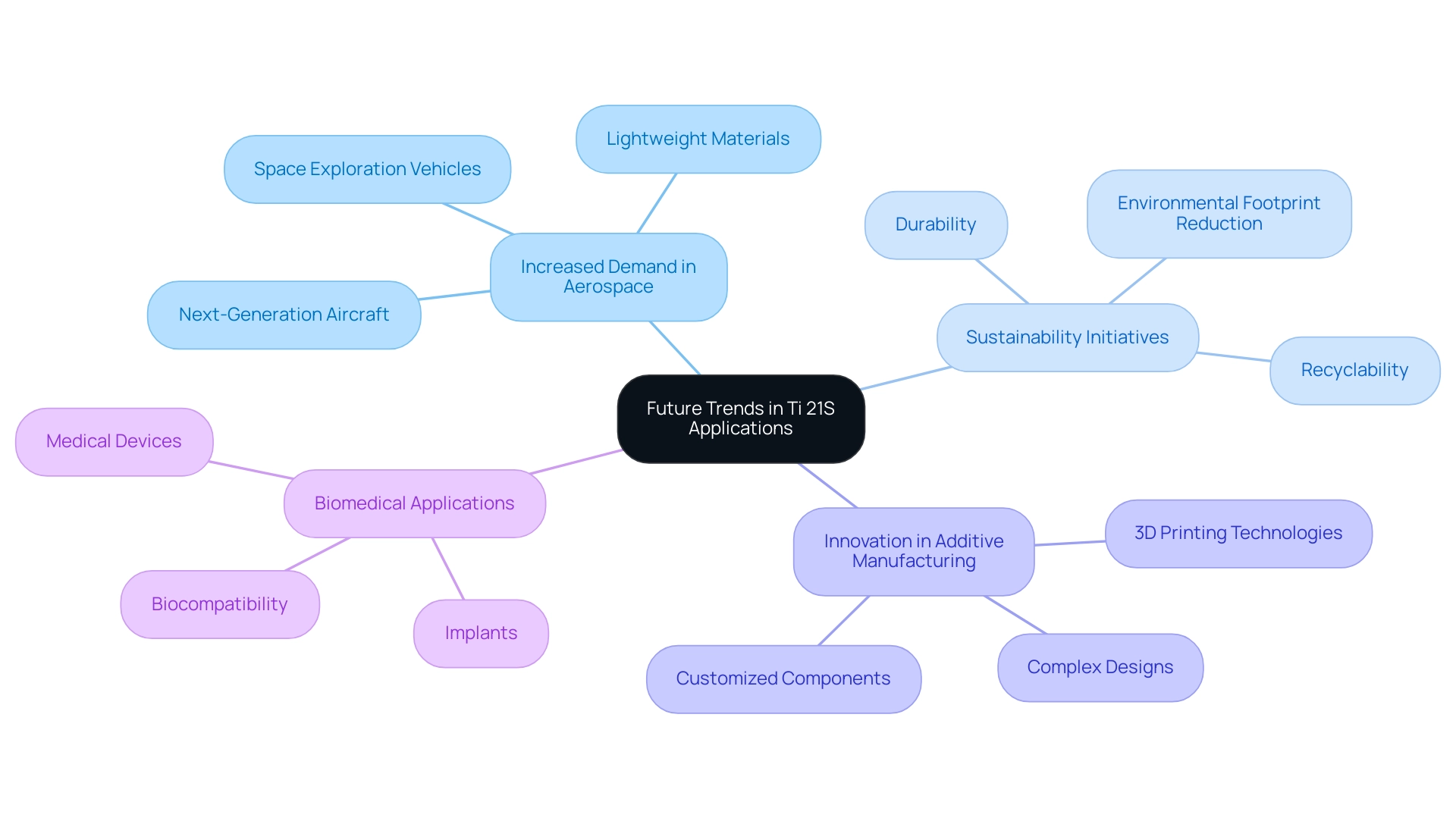
Conclusion
Ti 21S stands out as a transformative titanium alloy, showcasing exceptional properties that position it favorably across various industries. Its high strength-to-weight ratio, remarkable corrosion resistance, and versatility in manufacturing processes make it an invaluable asset in sectors such as aerospace, automotive, and biomedical devices. The ability to significantly reduce weight without sacrificing performance is particularly critical in aerospace applications, while its biocompatibility enhances its utility in medical settings.
In comparing Ti 21S to other established titanium alloys, it becomes evident that this innovative material not only meets but often exceeds industry standards in terms of performance and cost-effectiveness. Its advantageous characteristics, including durability and ease of fabrication, provide procurement managers with compelling reasons to prioritize Ti 21S over alternatives like Ti 6Al-4V and Ti 3Al-2.5V.
As the demand for high-performance materials continues to rise, staying informed about best practices for sourcing Ti 21S will be essential. By evaluating supplier credentials, conducting thorough material testing, and fostering long-term relationships with suppliers, procurement managers can optimize their strategies and ensure reliable access to this advanced alloy.
Looking ahead, the future of Ti 21S is bright, with trends indicating increased demand in aerospace, expansion in biomedical applications, and innovations in additive manufacturing. By embracing these developments, procurement professionals can strategically position themselves to leverage Ti 21S, driving innovation and operational efficiency in their organizations. The integration of Ti 21S into manufacturing processes not only enhances product performance but also aligns with sustainability goals, marking it as a pivotal choice in the evolving landscape of advanced materials.




